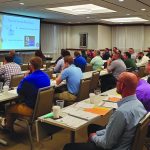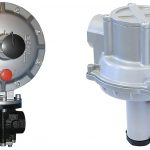Stocky, Fechte-Heinen elected to IFHTSE Executive Council
Christophe Stocky recently was elected to be a member of the IFHTSE Executive Council in Yokohama at the recent IFHTSE Congress. He is a...
IHEA grows its sustainability and decarbonization initiatives
With the popularity and success of this summer’s Sustainability & Decarbonization webinar series, the Industrial Heating Equipment Association (IHEA) announces an expansion of the...
Heat-treating workhorse – integral quench furnace
In this column, we will discuss the workhorse of the steel heat-treating industry – the integral quench furnace.
The integral quench furnace, or sealed quench...
Industrial automation and labor in heat treating
There is a changing landscape on two fronts in the thermal processing market. Without a doubt, there are technological opportunities that companies can take...
Quality staff: Understanding the technical side
Last month, we examined the history and heat-treatment of aluminum and how it applies to the quality functions of the industry. This month, we...
Getting to know IHEA member Nutec Bickley
On June 14, 1990, Nutec Industrial (later to become Nutec Bickley) was established in Monterrey, Mexico, expressly for the construction of furnaces, kilns, and...
IHEA member ECCO delivers innovative solutions for the natural gas industry
Equipment Controls Company (ECCO) was founded in 1965 as a distributor of liquid measurement controls systems for Rockwell. Over the years, the company has...
Surface stress is key in rolling contact fatigue
Most bearing failures can be attributed to some form of rolling contact fatigue. Many factors influence rolling contact fatigue, but two main factors are...
Q&A with Richard Slattery
Vice President, Engineering with Capstan Atlantic
Q&A with Daniel Reardon
What is Abbott Furnace's mission?
Our mission is to be the market leader in the design, production, and service of continuous process industrial furnaces. And...
Keeping thorough test records key to resolving issues
Record retention is an important part of quality. Quality is tasked with keeping records of periodic tests performed on all equipment used for heat...
Heat-treatment of modified 9CrMo steel
The modified 9CrMo steels, such as Grade 91, Grade 92, and HT9, are materials of choice for fossil-fuel-fired power plants and Next Generation Nuclear...
Determining Austenite Grain Size
Grain size is a critical metallurgical characteristic, significantly influencing design parameters such as strength and toughness. Austenite grain size (often referenced to as prior-austenite...
Q&A with Brian Kelly
The Industrial Heating Equipment Association (IHEA) recently announced its 2023-2024 board of directors and executive officers. Taking over as president is Brian Kelly of...
Heat treatment process modeling development for age-hardenable alloys
Age-hardenable alloys, such as some aluminum alloys, maraging steel, and nickel-based alloys, get their strength not from quenching but from the precipitation that occurs...
Simulation tools to effectively calculate process
One common goal for a wide range of industries has been to increase power density in shaft and gear components. The steel producing industry...
Developing a superalloy with superior heat resistance
Demand for superior machinery that can operate effectively under extreme conditions is driving the development of newer alloys. One significant example is the preparation...
Quenching from molten salt into polymer quenchants
In this column, I will discuss quenching aluminum from molten salt into a polymer quenchant.
A molten salt bath is a common method of heating...
Celebrating 50 years of IFHTSE in 2022
The 27th IFHTSE Congress will be in Salzburg, Austria, September 5-8, 2022, at the Wyndham Grand Salzburg Conference Center. This is going to be...
Q&A with Joe Coleman
What Is CMMC 2.0?
CMMC stands for Cybersecurity Maturity Model Certification. CMMC 2.0 is a contractual requirement for any non-federal organization or system that is...
Some workpieces are too large and expensive to fit into conventional benchtop hardness testers
Portable Rockwell Hardness Testing of Large Induction Hardened Work Pieces
The previous article identified many factors related to benchtop Rockwell hardness testing practices. This article...
Heat treatment of aluminum VI – Artificial aging
In the previous column, we described the fundamentals of natural aging. In natural aging, the solid solution obtained after quenching starts to form precipitates...
Major conferences planned for 2023
5th International Conference on Heat Treatment and Surface Engineering of Tools and Dies (HTSE-TD)
Hangzhou, China | April 24-27, 2023
This conference in Hangzhou, China, will...
Furnace Doors
No matter the configuration, single or multi-chamber vacuum, batch integral quench, continuous, or even pits — an item that all furnaces have in common...
Q&A with Tim Donofrio
Can-Eng Furnaces was recently awarded two contracts for its high-capacity line of mesh belt fastener heat treatment systems. What made this system ideal for...
Q&A with David Hamling
What’s a typical week like for you at ZIRCAR Ceramics?
I drive the company’s sales and marketing efforts and usually begin my day with a...
Residual stress evaluation in bearings
Lingering stress is not easily identified during production, but has a direct impact on wear performance and fatigue life
Heat treatment techniques overview
Editor’s note » This is the fourth in a five-part series.
In this fourth installment of my series on heat-treating techniques, I will discuss the pros...
Determining Grossman H-value from cooling curve data
In the last article, I described how the Jominy end quench test could be used to predict hardness for a series of different round...
Compelling reasons normalizing produces high quality gears
In this day and age, adding steps to the gear manufacturing process is not highly desirable unless the benefits far outweigh the costs incurred....
Q&A with Dante Molle
What does Aerospace Compliance Software (ACS) do for the heat-treat industry?
The goal of ACS is to streamline the process of completing and managing your...
The effect of catalysts on quench oil oxidation
In the last column, I discussed the effect of temperature on the oxidation of a quench oil. As was alluded to in my last...
True Carbon Potential
The relationship between a carbon-rich atmosphere and its effects on low-carbon steel are well known. The evolution of carburizing led to in-situ monitoring of...
Blistering of aluminum during heat treatment
In this column, we will discuss the blistering of aluminum during heat treatment, and methods to prevent its occurrence.
Introduction
High-temperature oxidation, or blistering, often occurs...
Quench tank agitation by submerged jets
In this column, I will discuss agitation by submerged jets.
Common methods of agitating quench tanks, and other types of tanks, are by sparging or...
The 2021 PRI Top 10 NRCs in heat treating
As the pandemic adjusted our lives and systems, we have still had to maintain Nadcap accreditation in heat treat and other commodities. While the...
Get ready for Heat Treat 2023
Heat Treat 2023, October 17-19 in Detroit, Michigan, will co-located with IMAT 2023 and the Motion+Power Technology Expo and cover many topics of interest....
‘Say what you do, do what you say’
In the special process world of the aerospace industry, companies with requirements of aerospace manufacturing must rely on the accreditation of AS9100 and the...
Intergranular corrosion of austenitic stainless steels
In this column, I will discuss the intergranular corrosion of austenitic stainless steels (3XX) and discuss the thermal processing causes.
Introduction
Austenitic stainless steels, such as...
Cruise into 2022: IHEA’s annual meeting sets sail in March
IHEA is in full preparation mode for the 2022 Annual Meeting aboard Royal Caribbean’s Brilliance of the Seas. This will be the third time...






















































